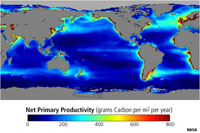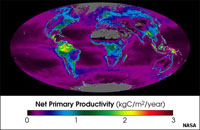13.10: Global and Seasonal Distribution of Plankton Biomass
- Page ID
- 10359
\( \newcommand{\vecs}[1]{\overset { \scriptstyle \rightharpoonup} {\mathbf{#1}} } \) \( \newcommand{\vecd}[1]{\overset{-\!-\!\rightharpoonup}{\vphantom{a}\smash {#1}}} \)\(\newcommand{\id}{\mathrm{id}}\) \( \newcommand{\Span}{\mathrm{span}}\) \( \newcommand{\kernel}{\mathrm{null}\,}\) \( \newcommand{\range}{\mathrm{range}\,}\) \( \newcommand{\RealPart}{\mathrm{Re}}\) \( \newcommand{\ImaginaryPart}{\mathrm{Im}}\) \( \newcommand{\Argument}{\mathrm{Arg}}\) \( \newcommand{\norm}[1]{\| #1 \|}\) \( \newcommand{\inner}[2]{\langle #1, #2 \rangle}\) \( \newcommand{\Span}{\mathrm{span}}\) \(\newcommand{\id}{\mathrm{id}}\) \( \newcommand{\Span}{\mathrm{span}}\) \( \newcommand{\kernel}{\mathrm{null}\,}\) \( \newcommand{\range}{\mathrm{range}\,}\) \( \newcommand{\RealPart}{\mathrm{Re}}\) \( \newcommand{\ImaginaryPart}{\mathrm{Im}}\) \( \newcommand{\Argument}{\mathrm{Arg}}\) \( \newcommand{\norm}[1]{\| #1 \|}\) \( \newcommand{\inner}[2]{\langle #1, #2 \rangle}\) \( \newcommand{\Span}{\mathrm{span}}\)\(\newcommand{\AA}{\unicode[.8,0]{x212B}}\)
Global and Seasonal Distribution of Plankton Biomass
Figure 13.22 shows the net productivity of the oceans observed from satellite data. Figure 13.23 compares ocean productivity to regions on vegetation cover on land. In general, plants on land have access to more concentrated light, but the availability of water and nutrients are a factor of climate and geology. Although tropical forests account for a large volume of biomass, the volume is a fraction of the amount of biomass in the oceans because of the differences in surface area. Productivity in the oceans are influenced by atmospheric and oceanographic factors:
- Tropics: Reliable sunlight but the strong tropical thermocline prevents mixing of cold deep nutrient rich water. The warm water on top is too buoyant. The exception to this are coral reef areas.
- Temperate: Reliable sunlight and weak thermocline. Most productive zone. In California we get lots of production in the winter as that’s when we get upwelling from our coastal winds.
- Polar regions: Lots of nutrients little or no thermocline. Sunlight limited only in the few months of summer, but is highly productive.




